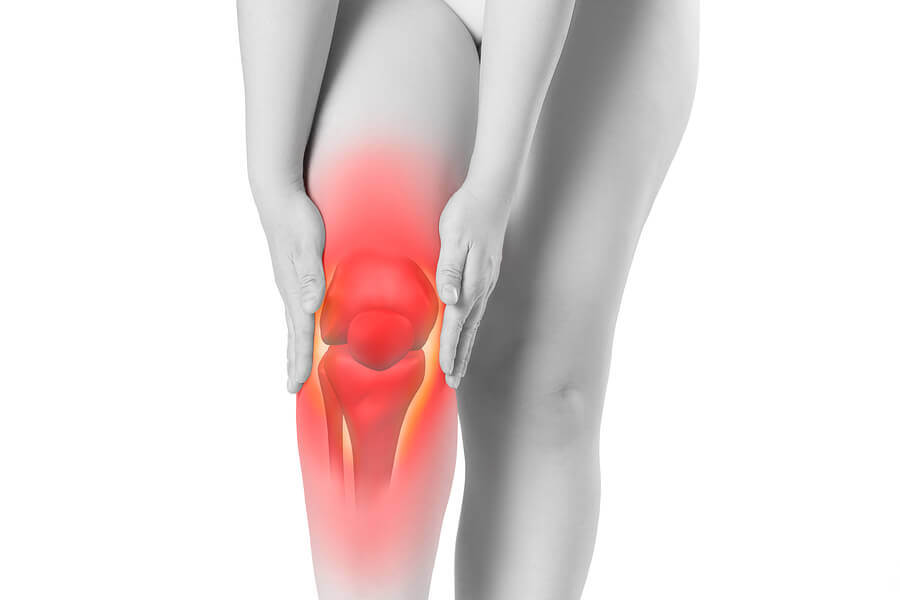Stress Fractures in the Tibia: Symptoms and Treatments

Stress fractures in the tibia, or anywhere else in your body, are caused by overdoing your workouts and ignoring muscle imbalance. This is especially true when you practice high-intensity sports or are on track to becoming a professional athlete.
Although simple, this injury can set you back and, if left untreated, wreak havoc in your career. In today’s article, we’ll cover everything you need to know about them!
Simply put, stress fractures or overload fractures are small cracks that appear in the bones. This is especially frequent in the bones that support your weight.
Causes and symptoms of stress fractures
Stress fractures usually appear due to excessive sports load. This is because you’re using the same body part for a long time and repetitively. Thus, the body is suffering impacts until, as in a wall, small cracks begin to appear. Because of it, it will be a more frequent pathology in high impact sports such as basketball or track.

These fractures can also appear due to a sudden increase in workout intensity. If we aren’t used to a certain exercise and suddenly, we do it many times and with considerable weight, the bones won’t be ready for it. Then, one of the consequences may be a stress fracture.
On the other hand, if your body is subject to an intense workload, you might want to consider a nutritional cause. In fact, stress fractures may also appear due to a lack of nutrients. If the bone doesn’t have access to all the resources it needs, it can weaken and become prone to suffering from this type of pathology. Diseases such as osteoporosis and lack of calcium will also predispose us to it.
Finally, we must take care of our main support: the feet. Knowing if you have a flat foot or very high arches -and looking for a solution- will lower the risk of suffering this injury. It will also be vital to wear appropriate footwear when we practice sports.
Of course, it’s important to note that, if you had overload fractures before, you‘d be more likely to suffer them again in the future.
Symptoms of stress fractures in the tibia
Stress fractures in the tibia are quite common. The muscles in the front of the leg aren’t usually worked much, and instead, we favor the back. This means that the muscle in the back is pulling the tibia without any resistance. Thus, your risk of stress fractures in this area rises considerably.
In the initial stages of a stress fracture, you’ll only notice slight discomfort in the area of the shin. This discomfort will disappear at rest.
Then, that localized pain will go further, and you’ll begin to notice that the area is inflamed: swollen, red and hot. You might also begin to notice pain at night, and the affected area will be very sensitive to touch or shock.
There won’t be any further symptoms of a stress fracture. Because of it, getting an accurate diagnosis can be complicated. A physician will rule out other conditions such as tendon issues, periostitis, and compartment syndrome, among other issues. Thus, it’s important to see a doctor to perform the necessary tests and find a successful diagnosis.
Treatment of stress fractures in the tibia
The treatment of stress fractures usually focuses on giving proper rest to the affected limb. We may need crutches or other physical aids to take the load off the leg. However, whatever the recommendation is, it’s key to let the bone recover.
In most cases, after six weeks, the bone will have regained strength and you can start walking as usual again.

Training after the injury
During this time, it’s important to perform physical activity that doesn’t involve great pressures on the affected bone, such as swimming or cycling. In turn, this will maintain physical fitness and normal bone recovery cycles.
Of course, you can also take anti-inflammatory medication to help reduce symptoms if you deem it necessary. Another alternative is to apply ice or cold packs on the affected area, which will also help control inflammation.
Then, the recovery process will begin. In this post-injury stage, you must focus on strength training. Gaining more muscle mass will help to lift the load off your bones. With strong muscles and in good condition, you’ll significantly lower the possibility of relapse.
Ultimately, it will also be important to add load gradually. Thus, you shouldn’t start practicing sports again as if nothing had happened. You must start by doing the minimum. In turn, this will allow you your body to get into the training again.
Stress fractures in the tibia, or anywhere else in your body, are caused by overdoing your workouts and ignoring muscle imbalance. This is especially true when you practice high-intensity sports or are on track to becoming a professional athlete.
Although simple, this injury can set you back and, if left untreated, wreak havoc in your career. In today’s article, we’ll cover everything you need to know about them!
Simply put, stress fractures or overload fractures are small cracks that appear in the bones. This is especially frequent in the bones that support your weight.
Causes and symptoms of stress fractures
Stress fractures usually appear due to excessive sports load. This is because you’re using the same body part for a long time and repetitively. Thus, the body is suffering impacts until, as in a wall, small cracks begin to appear. Because of it, it will be a more frequent pathology in high impact sports such as basketball or track.

These fractures can also appear due to a sudden increase in workout intensity. If we aren’t used to a certain exercise and suddenly, we do it many times and with considerable weight, the bones won’t be ready for it. Then, one of the consequences may be a stress fracture.
On the other hand, if your body is subject to an intense workload, you might want to consider a nutritional cause. In fact, stress fractures may also appear due to a lack of nutrients. If the bone doesn’t have access to all the resources it needs, it can weaken and become prone to suffering from this type of pathology. Diseases such as osteoporosis and lack of calcium will also predispose us to it.
Finally, we must take care of our main support: the feet. Knowing if you have a flat foot or very high arches -and looking for a solution- will lower the risk of suffering this injury. It will also be vital to wear appropriate footwear when we practice sports.
Of course, it’s important to note that, if you had overload fractures before, you‘d be more likely to suffer them again in the future.
Symptoms of stress fractures in the tibia
Stress fractures in the tibia are quite common. The muscles in the front of the leg aren’t usually worked much, and instead, we favor the back. This means that the muscle in the back is pulling the tibia without any resistance. Thus, your risk of stress fractures in this area rises considerably.
In the initial stages of a stress fracture, you’ll only notice slight discomfort in the area of the shin. This discomfort will disappear at rest.
Then, that localized pain will go further, and you’ll begin to notice that the area is inflamed: swollen, red and hot. You might also begin to notice pain at night, and the affected area will be very sensitive to touch or shock.
There won’t be any further symptoms of a stress fracture. Because of it, getting an accurate diagnosis can be complicated. A physician will rule out other conditions such as tendon issues, periostitis, and compartment syndrome, among other issues. Thus, it’s important to see a doctor to perform the necessary tests and find a successful diagnosis.
Treatment of stress fractures in the tibia
The treatment of stress fractures usually focuses on giving proper rest to the affected limb. We may need crutches or other physical aids to take the load off the leg. However, whatever the recommendation is, it’s key to let the bone recover.
In most cases, after six weeks, the bone will have regained strength and you can start walking as usual again.

Training after the injury
During this time, it’s important to perform physical activity that doesn’t involve great pressures on the affected bone, such as swimming or cycling. In turn, this will maintain physical fitness and normal bone recovery cycles.
Of course, you can also take anti-inflammatory medication to help reduce symptoms if you deem it necessary. Another alternative is to apply ice or cold packs on the affected area, which will also help control inflammation.
Then, the recovery process will begin. In this post-injury stage, you must focus on strength training. Gaining more muscle mass will help to lift the load off your bones. With strong muscles and in good condition, you’ll significantly lower the possibility of relapse.
Ultimately, it will also be important to add load gradually. Thus, you shouldn’t start practicing sports again as if nothing had happened. You must start by doing the minimum. In turn, this will allow you your body to get into the training again.
All cited sources were thoroughly reviewed by our team to ensure their quality, reliability, currency, and validity. The bibliography of this article was considered reliable and of academic or scientific accuracy.
- Fracturas de estrés mecánico en los huesos del pie en practicantes de deportes de mantenimiento. B. Carpintero, C. Calle, H. Jiménez et al., Rev Cubana Ortop Traumatol [Internet]. 1995; 9( 1 ): 145-149.
- P. Lafforgue. Fracturas por sobrecarga (fracturas por fatiga y fracturas por insuficiencia ósea). EMC – Aparato Locomotor. Vol. 46, Issue 3 (2013); 1-12
- S. Muñóz, P. Paolinelli. Reacciones del hueso frente al estrés: Estudio radiológico. Rev. chil. radiol. [Internet]. 2005; 11( 2 ): 81-90.
This text is provided for informational purposes only and does not replace consultation with a professional. If in doubt, consult your specialist.








